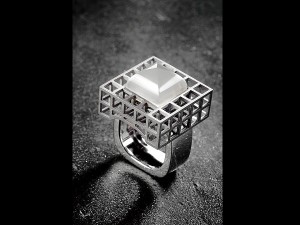
While other jewelry dazzles with diamonds and stones, Hans Brumann has become known for his rich imagery that never fails to surprise and to leave in awe the buyer or spectator (like us who can’t always afford his pieces—sometimes, yes).
His is a craftsmanship which apparently he and his workshop alone can produce—it’s not only intricate and detailed, it is also tedious and daring.
The yearend collection he unveiled two weeks ago at Makati Shangri-La, where he has a store, is curiously titled “Beauty and the Beast.”
And—the “Beast” pieces are more affordable, using silver or brass. He made this delineation between “Beauty” and the “Beast” because he wanted to reach a broader market, way beyond the very loyal Brumann clientele who can fork out a seven-figure sum for jewelry, and Brumann has a steadfast and loyal clientele who looks forward to his annual collection.
Blister pearls
Brumann, this time, showcases what he can do with “blister pearl,” capitalizing on its shape—that bulge—and its texture. One never thought biomorphism could look this elegant, but in the hands of Brumann, it can and does. There is a silver (gold-plated) bracelet with one mother-of-pearl blister that’s shaped like a Christmas tree cut in half. It’s strung with other mother-of-pearls, one of which is shaped like a fish, and also with nine corals, one red coral, one freshwater pearl, six lapis lazuli and one cabochon sapphire.
The Kenneth Cobonpue ring is 14k white gold with a moonstone. The ring is a square frame of symmetrical holes, like a Cobonpue chair—a three-dimension wonder of craftsmanship which, Brumann himself admitted, was not easy to make.
Brumann has kept these precious raw materials, such as the mother-of-pearl, through the years, and brought them out early this year to start working on them. The Christmas tree-shaped mother-of-pearl, for instance, had been in a storage box since the 9/11 New York disaster; he was about to use it for a collection.
Despite his horde of precious and semi-precious stones, however, Brumann has always believed that the beauty of jewelry lies not only in the material itself, but more so, in the design and craftsmanship.
The master jeweler has a playful imagination and perhaps even more playful hands that allow him to up the ante, where craftsmanship is concerned.
To this day, Brumann loyalists love how he makes rings or pendants using kamagong. “I love the natural color of wood,” he told us.
In Switzerland, where he was born, as he was at the point of preparing for a career, he was made to choose—he could be a dentist, a goldsmith or a baker (he comes from a family of bakers).
“But I didn’t like looking at teeth all my life,” he recalled the decision he made.
He had always wanted to be a graphic designer. To be a goldsmith was the closest to it.
He never left the Philippines, and put up his own workshop and jewelry line, which has developed a lucrative following through the decades.
Perhaps not known to many, Brumann is a Filipino citizen. He applied for naturalization more than 40 years ago. And he and wife Maria have advocacies and scholars, among them their workshop employees.
Brumann also has a gallery at Greenbelt 5 where, the day before the unveiling of the “Beauty and the Beast” collection, the latest sculpture works of Brumann and paintings of Norberto Carating were presented.
Talk-stoppers
Overheard at recent dinners:
A designer bewailing the exorbitant rates of today’s young artists—“There are no more starving artists, only starving collectors.”
A society watcher trying to describe a certain woman: “Well, she’s not up-and-coming. And she’s no has-been—because she’s never really been.”